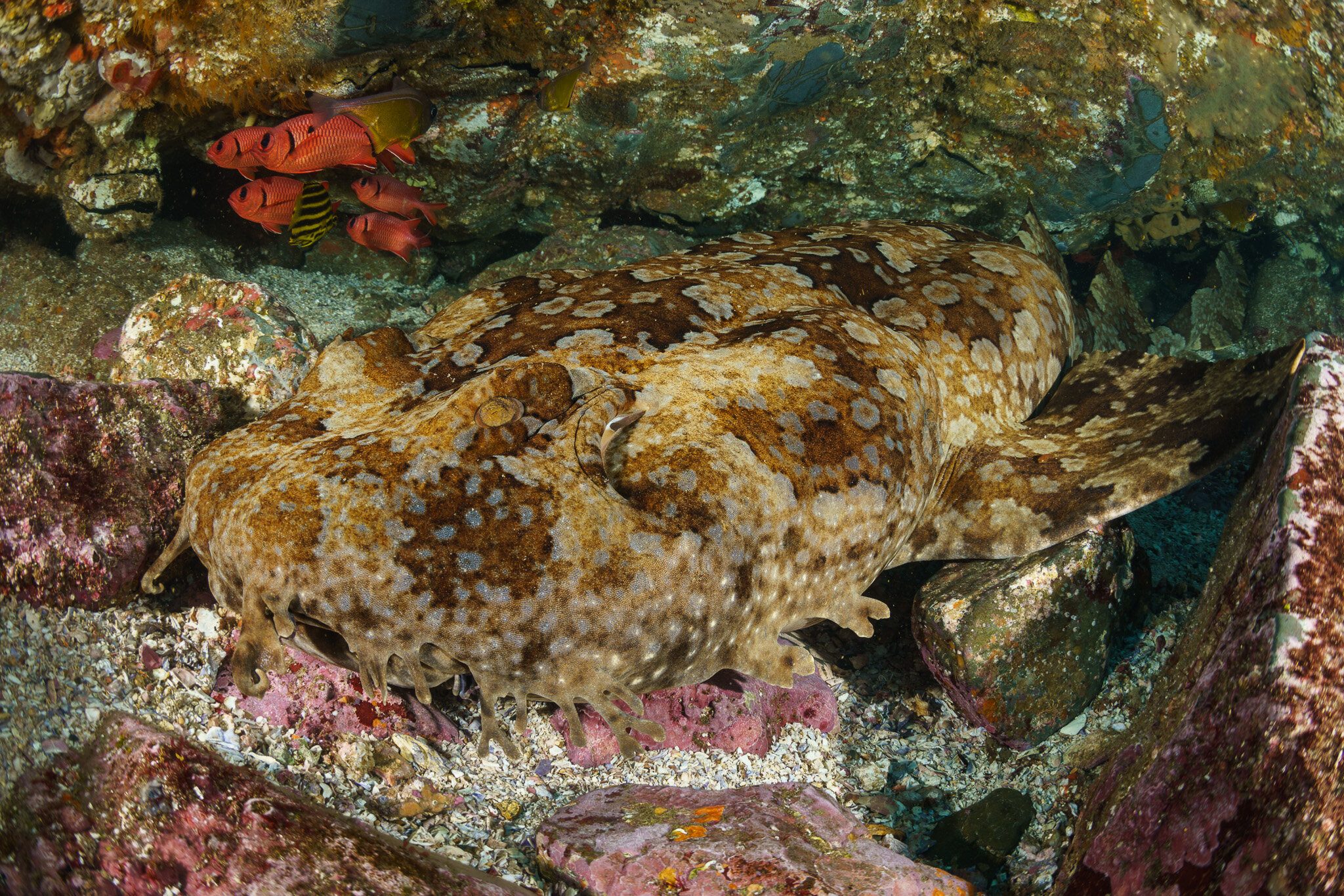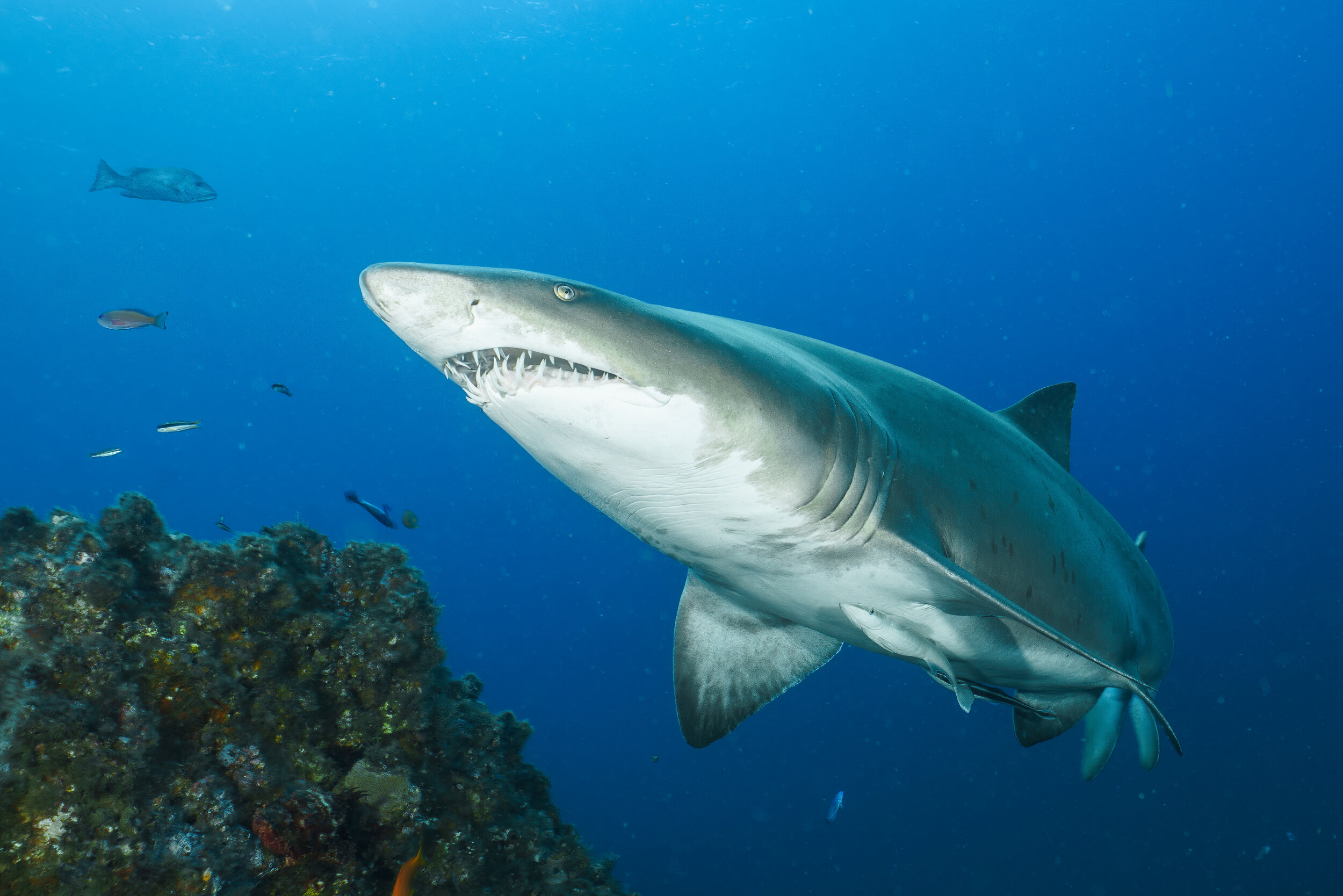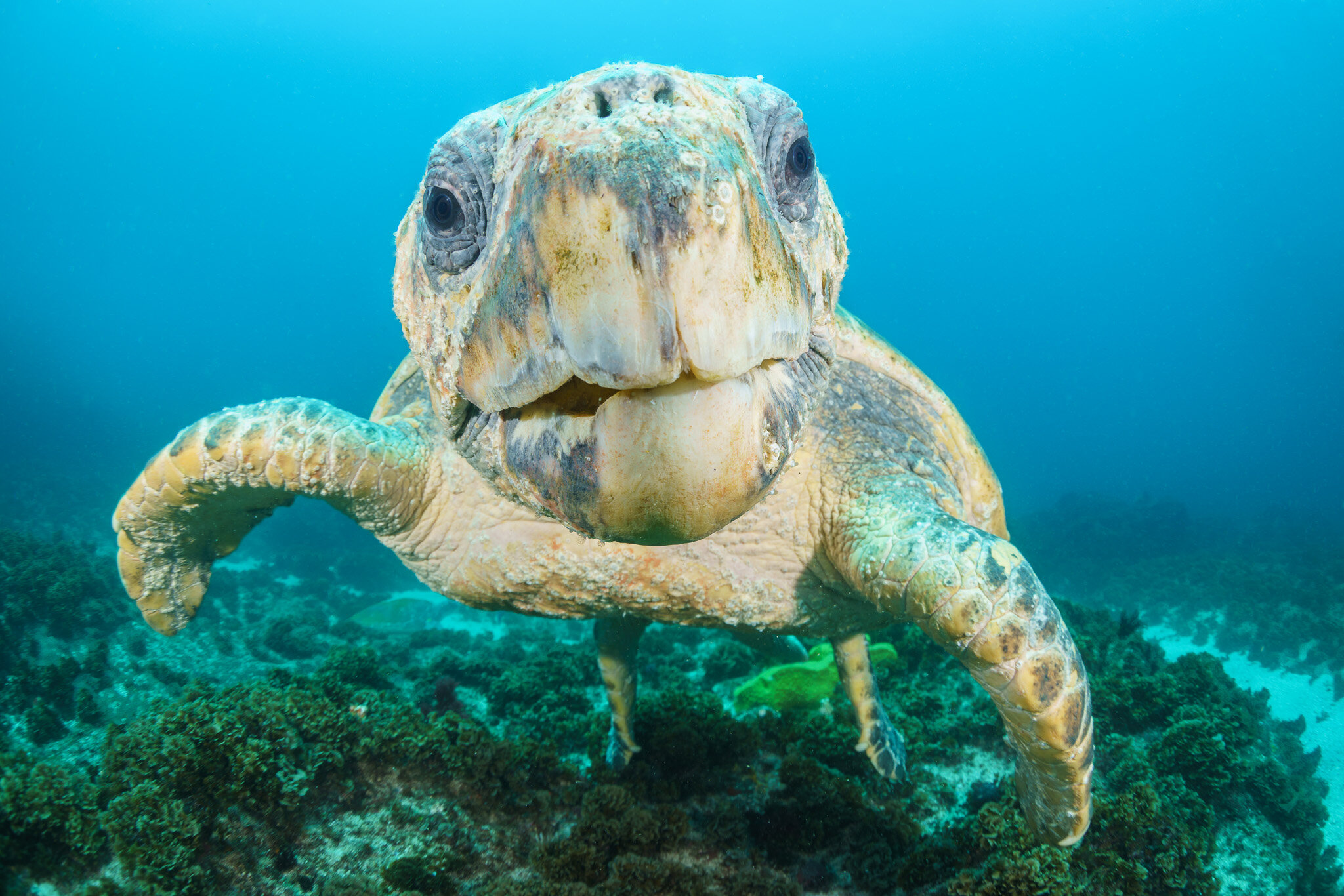Diving in Byron Bay, Australia: The World’s Best Temperate Shark Dive?
Dr. Simon J Pierce is a co-founder of the Marine Megafauna Foundation, where he leads the global whale shark research program, and an award-winning marine wildlife photographer. About Simon.
Leopard shark. As designed by Disney, probably.
+ Contents
- Where are Julian Rocks, Byron Bay?
- Why is there so much marine life?
- Sharks at Julian Rocks in Byron Bay
- Diving at Julian Rocks in Byron Bay
- Not a diver? No worries!
- Byron Bay Accommodation
- Underwater Photography Notes for Julian Rocks in Byron Bay
Julian Rocks Nguthungulli Nature Reserve, just off the famed beaches of Byron Bay, is one of Australia’s – and the world’s – best shark dives. No hyperbole. Julian Rocks… rocks.
(Sorry.)
Enough with the dad jokes. Where are Julian Rocks?
Byron Bay and Julian Rocks. Photo by Zoltan Kovacs.
Well, clearly you’re new here. But okay.
Julian Rocks are a pair of rocky outcrops named Juan and Julia. Honestly. They’re located just 2.5 km off the main beach at Byron Bay in northern New South Wales, one of the most popular tourist destinations in Australia. Byron is also the easternmost point of the country.
Despite the accessible locale, it’s not a crowded site. It’s rare to see other people, even from your own boat, underwater.
The rocks themselves are uninhabited, apart from eleventy-billion birds, and they aren’t particularly imposing. Juan, the taller of the two, reaches 19 m in height. You could probably swim right around the pair in an hour or so if you really wanted to.
You won’t want to though. There are a lot of distractions underwater. Over 1,000 marine species visit the area, and the locals are friendly. Or hungry, in some cases…
Why is there so much marine life?
Julian Rocks’ subtropical location is near the southern extent of range for lots of warm-water species, including exotic tropical minibeasts like the ornate ghost pipefish and megabeasts like reef manta rays, and represents a northern holiday for cooler critters like grey nurse sharks. It’s a transit area for migratory species, as well as home for hundreds of residents.
Camera-munching loggerhead turtles, huge schools of fish and the 100+ nudibranch species are all divertingly wonderful but, to me, it’s the 20+ shark and ray species that really dominate the place.
Three species of wobbegongs – which look and act like rugs – carpet the bottom. Grey nurse sharks (= sandtigers) loiter in the sandy gutters through winter and spring, then hundreds of adorable leopard sharks (= zebra sharks) stage the world’s least hostile takeover in early summer. Even rarities like the Colclough’s shark are present at the rocks.
It’s all a bit overwhelming for an elasmophile like myself.
Banded wobbegong
The Sharks of Julian Rocks
Oddly, considering Byron Bay’s huge popularity as a beach tourism destination – every backpacker passes through on their migration along the eastern Australian coast – the site still flies under the radar as a scuba diving and snorkeling destination. Which is crazy.
Julian Rocks is one of the world’s best shark dives.
Forming a small part of the Cape Byron Marine Park, Julian Rocks Nguthungulli Nature Reserve has been fully protected from fishing since 2006. There hasn’t been much shark population monitoring done to formally quantify the effectiveness of the sanctuary, but an underwater video study showed a significant increase in sightings of grey nurse sharks at Julian Rocks between 2006 and 2012.
Grey nurse are critically endangered on Australia’s east coast, so this is huge.
Counts of other shark and ray species also approximately doubled inside the sanctuary, relative to nearby reefs where fishing is allowed, over that period.
Smiley grey nurse shark
Grey nurse sharks, as well as other species such as wobbies, are fish-eaters. Their increasing presence in Byron Bay is likely to be a result of the higher density of other fish – potential prey – around the rocks. Fish abundance and species diversity all increased at Julian Rocks between 2006 and 2014.
It’s awesome to see that these conservation measures are working. As a shark biologist myself, I’m not new to shark population monitoring. After a few dives, I’m totally comfortable saying that the shark abundance at Julian Rocks is the highest I’ve ever seen in temperate waters. In fact, it’s the highest density of sharks I’ve seen anywhere in the world outside the famed shark hotspots in the Galápagos Islands and in Tubbataha Reefs in the Philippines, both of which are World Heritage Listed.
That is seriously good company.
Wobbie cuddle puddle
I haven’t even been to Byron Bay during the peak shark diving seasons yet – mid-winter (July / August) for grey nurse, or summer (February / March) for leopard sharks. Still, in a single 50-minute dive I’ve counted up to 50 wobbegong sharks, as well as several leopard sharks, a grey nurse shark, bronze whalers, and multiple species of rays.
More than a shark a minute. My kinda diving.
Diving at Julian Rocks in Byron Bay
I’d only dived Byron Bay a couple of times previously, way back in Ye Olden Dayes when I was studying at The University of Queensland in Brisbane. Then, at the end of 2018, shark scientist Dr David Robinson and photographer Simone Caprodossi bought Sundive dive and snorkeling center, which specializes in diving Julian Rocks.
Loggerhead turtle
I’ve known David and Simone for over a decade now so, of course, I invited myself over there so fast that I literally attended their launch party.
The sharks are at Julian Rocks naturally – no bait is used to attract them – but they’re generally very relaxed, so you’ll be able to get a good look at them. One of the really nice things about Byron Bay is that the diving is pretty easy. There can be some current on the northern side of the rocks (the Cod Hole), so the boat will often pick you up after a one-way drift dive. Descending is simple. The boat will attach to a mooring buoy, which allows you to descend down the rope at your own pace.
Advanced divers can explore to their heart’s content – up to the 50 min dive limit – but Open Water divers can also see all the things. Most of the action is shallower than 18 m, and you’ll be guided around by Sundive’s experienced instructors and divemasters. There’s a maximum of six divers per guide.
Julian Rocks is a great spot to do an Adventure dive (instructor-led deep dive), which counts towards your Advanced certification, or stay for a couple of days and do the full course. If you’re a snorkeler or a new diver (Discover or Open Water), you’ll have a fantastic time too. More on that below.
The Cod Hole
The visibility is highly variable. Late summer (February / March) tends to have the warmest water, best visibility (i.e. 20 m+), as well as large numbers of tropical sharks and rays, but it’s an excellent dive all year round. When I came over in December 2018 the leopard sharks and manta rays had already arrived, but the grey nurse were still there too.
Mid-winter has the largest number of grey nurse sharks and a bonus choral accompaniment to your dive from migrating humpback whales. The cooler water (18–21ºC) is well worth it. Brrr. I use a nice warm hooded vest (I absolutely love my Sharkskin) and a warm rash shirt underlayer to stay warm.
Spotted wobbegong
Julian Rocks are only 10 minutes offshore, so there’s minimal time on the boat. It’s not a rough ride. It’s a single-tank dive, so you’re not bobbing about the surface for long either.
Planning a trip? Don’t forget to purchase travel insurance!
We use World Nomads to insure us while we’re scuba diving, snorkeling, hiking, on safari, in the Arctic… whenever we’re out and about while overseas. We’ve written up a full article on why we like World Nomads here on the site.
Sundive is a fully equipped dive center – you can rent a full set of gear there, and buy anything you need. If you’re after our recommendations on the best dive gear to purchase, though, do check out our scuba and snorkel gear guides.
Not a diver? No worries!
If you’re keen to try scuba diving, there’s a Discover Scuba option where you do a quick pool lesson, then head out for a dive at the rocks. There are regular snorkeling trips to Julian Rocks as well, again with a guide, which we can highly recommend – Mads took her brother and his family out there to check out the leopard sharks and turtles, and they all had a brilliant time.
Byron Bay Accommodation
We generally stay out close to the little wildlife photography gem that is Arakwal National Park, because wallabies, but Sundive is right in central Byron, so there are a ton of well-reviewed options nearby. Check out the map here.
Underwater Photography Notes for Julian Rocks
Any gear will be good for Julian Rocks – it’s a target-rich environment, and there’s a huge diversity of subjects. All of the underwater photos in this article were taken with my Sony A7rIII camera in a Nauticam NA-A7RIII housing, with a Canon 8-15 mm fisheye lens (on a Metabones V adapter), and dual YS-D2 strobes. Check out my underwater wide-angle photography settings article for general details on how I shoot with this setup.
I always love my fisheye, and I think it’s a great lens for leopard sharks and wobbies – the ultimate “close-focus wide-angle” subjects – but a wide-angle rectilinear lens might be better for the grey nurse, as they’ll likely be a little further away. David and Simone both use Canon 14 mm wide-angle lenses on Canon 5DS R cameras. Check out Simone’s and David’s photos to see what’s possible with that setup.
If you want to learn or improve your underwater photography, I highly recommend Alex Mustard’s book: Underwater Photography Masterclass. It’s a fantastic guide to a rather technical subject!
Ornate wobbegong
Blue-spotted maskray
Banded wobbegong
Thanks a million to David and Simone, and the whole Sundive team, for hosting us!
Simon.




















